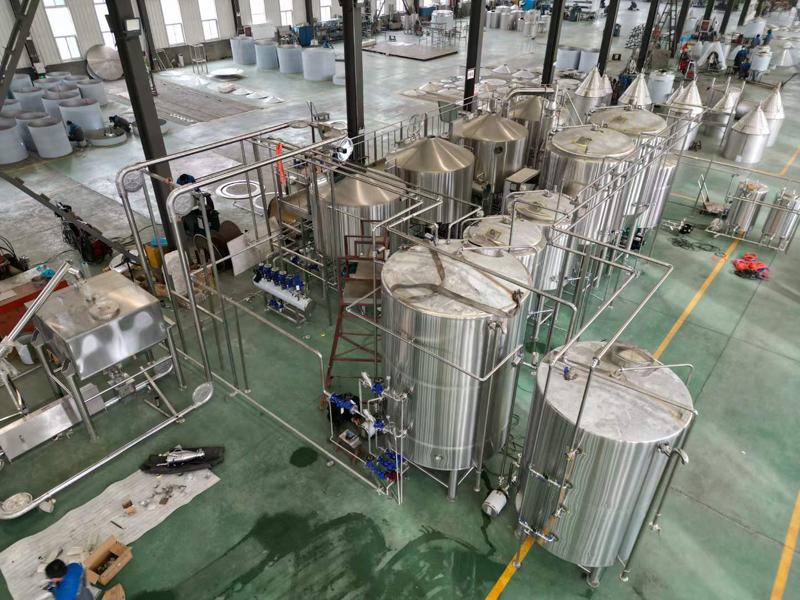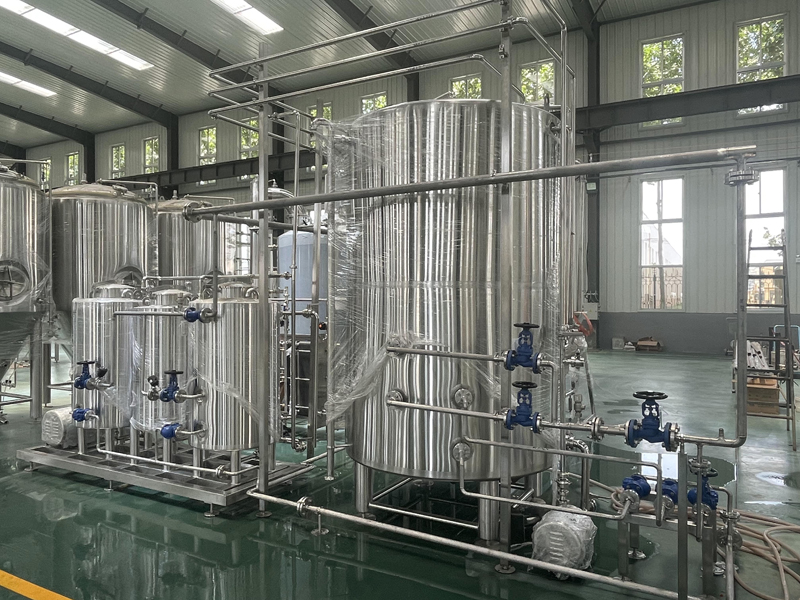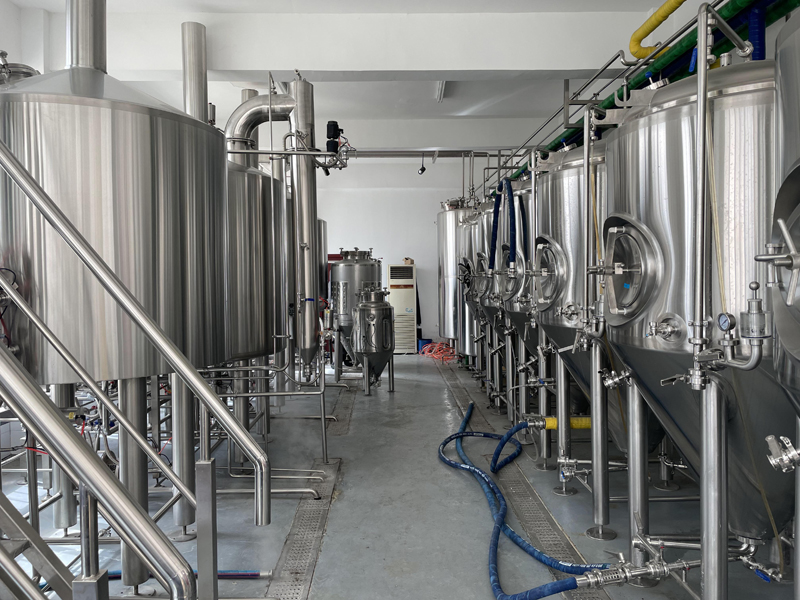The important of HLT and CLT in brewing process
In brewing, water plays a critical role throughout the process, and two key vessels responsible for managing water at specific temperatures are the Cold Liquor Tank (CLT) and Hot Liquor Tank (HLT). Though both tanks serve essential functions in beer production, they have distinctly different roles. The Cold Liquor Tank is designed to store chilled water, which is primarily used to cool down the wort after the boiling process, ensuring the beer can ferment at the correct temperature. In contrast, the Hot Liquor Tank holds heated water used in mashing and sparging to extract fermentable sugars from malted grains. Understanding the differences between these tanks is essential for efficient brewery operations, as they work in tandem to regulate temperature, energy usage, and water supply. This article explores the specific roles of both tanks and their impact on the brewing process, from energy management to production quality.
1.What’s the Liquor in brewing
2.Integration of CLT and HLT in the Brewing Process
3.Importance of Sizing HLT and CLT
4.Summary
1.What is Liquor in Brewing?
In the world of brewing, the term“liquor”refers not to alcoholic beverages but to water that has been treated and conditioned for use in the brewing process. Water, or liquor, is one of the primary ingredients in beer, and its quality and characteristics can significantly affect the brewing outcome. Factors like mineral content, pH level, and hardness are carefully managed to ensure optimal brewing conditions. Breweries often treat water to suit the specific style of beer being produced, as these factors influence the flavor, fermentation efficiency, and yeast health. Liquor is used at various stages of brewing, and its temperature is critical to each process, leading to the differentiation between cold and hot liquor.
Cold Liquor and Hot Liquor
In brewing, cold liquor, and hot liquor serve distinct functions, with each playing a vital role in specific stages of the brewing process:
-Cold Liquor: This refers to water that has been chilled, typically stored in a Cold Liquor Tank (CLT). Cold liquor is primarily used in the cooling phase, particularly during wort cooling after boiling. It helps bring the temperature of the wort down to fermentation levels by passing through a heat exchanger, which cools the wort quickly, preventing contamination and preserving flavor. The cold liquor is also occasionally used for temperature control during fermentation or in the cleaning of brewing equipment.
-Hot Liquor: In contrast, hot liquor refers to water that has been heated and is stored in the Hot Liquor Tank (HLT). Hot liquor is used in mashing, where the malted grains are steeped to activate enzymes that convert starches into fermentable sugars. It is also used during sparging, where the grain bed is rinsed to extract residual sugars. The precise temperature of the hot liquor ensures efficient mashing and rinsing, which in turn affects the quality and flavor of the beer.
Both cold and hot liquor are indispensable in brewing, providing temperature control and energy efficiency across different phases of the process. Together, they form an essential part of the brewing system, ensuring the beer is crafted with precision and consistency.
2.Integration of CLT and HLT in the Brewing Process
Brewing System Configurations
In modern brewing systems, the cold liquor tank (CLT) and hot liquor tank (HLT) are integrated as essential components of the brewing setup. They are designed to support various stages of the brewing process, from mashing to wort cooling. Depending on the size and complexity of the brewery, system configurations can vary:
-Basic Systems: In smaller breweries, the CLT and HLT are often standalone vessels connected to a heat exchanger for wort cooling and to a mash tun for mashing and sparging.
-Advanced Systems: In larger brewing systems, these tanks are part of a fully integrated setup, connected to automated controls, heat recovery systems, and multiple brewing vessels, allowing for greater efficiency and precision. This setup often includes temperature sensors, monitoring systems, and energy optimization technologies.
Interdependence of Hot and Cold Liquor Tanks
Although the CLT and HLT serve distinct functions, they are interdependent and work together to ensure smooth brewing operations:
-Wort Cooling: After the boiling stage, the CLT supplies cold water to cool the wort in the heat exchanger. The heat that the cold liquor absorbs from the wort can then be redirected, using heat recovery technology, to the HLT. This warmed water can be used in the next brewing cycle, reducing the need to reheat fresh water.
-Mashing and Sparging: The HLT supplies hot liquor to the mash tun for sparging, ensuring the proper extraction of fermentable sugars. After this process, excess water can sometimes be cooled down and redirected to the CLT, creating a closed-loop system for water use. This interplay between the CLT and HLT minimizes waste and ensures that both cold and hot water are available exactly when needed.
Energy Efficiency Considerations
Energy efficiency is a major concern in breweries, and integrating the CLT and HLT in an intelligent brewing system can significantly reduce energy consumption:
-Heat Recovery Systems: By capturing the heat from the wort cooling process and transferring it to the hot liquor for the next brew cycle, breweries can reduce their reliance on external heating elements or gas burners, cutting down energy use.
-Insulation: Both the CLT and HLT are well-insulated to minimize heat loss or gain, ensuring that minimal energy is required to maintain their respective temperatures. This reduces the need for continuous energy input to reheat or re-chill water.
-Water Re-circulation: Many breweries use water re-circulation systems, where water from the HLT can be cooled and stored in the CLT, or vice versa. This reduces water waste and minimizes the need for fresh heating or chilling of water, which in turn lowers energy consumption.
Incorporating both tanks into an efficient system not only helps improve energy efficiency but also reduces water usage, making the brewing process more sustainable. Through the proper integration of the cold liquor tank and hot liquor tank, brewers can optimize their operations, lower costs, and minimize environmental impact.

3.Importance of Sizing HLT and CLT
How to Size Hot and Cold Liquor Tanks for Your Brewery
Properly sizing your hot liquor tank (HLT) and cold liquor tank (CLT) can help ensure a smooth and efficient brewing operation. Tanks that are too small may lead to production delays, while oversized tanks can result in energy inefficiencies and increased costs. The goal is to find the optimal balance based on your brewery’s production volume and schedule:
-HLT Sizing: The HLT must be large enough to supply the necessary hot water for mashing, sparging, and cleaning operations. As a general rule, the HLT capacity should be at least 1.25 to 1.5 times the volume of your brew kettle, ensuring enough hot liquor is available for multiple processes within a single brew day.
-CLT Sizing: The CLT should be sized to provide enough cold water to cool down the wort efficiently. The required CLT capacity is typically about the same as the batch size, ensuring you have enough cold liquor to quickly cool the wort through the heat exchanger.
Factors Influencing Tank Size
Several factors will influence the appropriate size of your hot liquor tank and cold liquor tank:
-Brewery Production Volume: The larger the brewery and the higher the production capacity, the larger both the HLT and CLT need to be. High-production breweries often require multiple batches in a single day, meaning the tanks need to accommodate a continuous supply of hot and cold water.
-Batch Size: The size of your brewing batches directly impacts the size of the tanks. Larger batches require more hot liquor for mashing and sparging and more cold liquor for wort cooling.
-Brewing Frequency: Breweries that produce multiple batches per day or week require larger tanks to avoid downtime between brews. A larger HLT ensures sufficient hot water supply for back-to-back batches, while a larger CLT ensures that wort can be cooled quickly without waiting for water to be re-chilled.
-Heat and Cooling Recovery Systems: If your brewery uses advanced heat recovery systems, this may allow for smaller HLT and CLT sizes, as you can recapture and reuse water more efficiently. In these cases, the tanks may not need to store large volumes of water simultaneously, as water can be recycled throughout the brewing process.
-Energy Efficiency Goals: Larger tanks often consume more energy for heating and cooling, so brewers need to carefully assess their energy usage and balance the tank size with energy efficiency. Insulated tanks can help reduce energy demands, but sizing must be carefully calculated to avoid waste.
Properly sizing your HLT and CLT ensures that your brewery runs smoothly without interruptions, minimizes energy consumption, and reduces water waste, all of which contribute to efficient, cost-effective brewing operations.
4.Summary
The cold liquor tank (CLT) and hot liquor tank (HLT) are essential components in any brewery, each playing a vital role in different stages of the brewing process. The CLT stores chilled water, which is primarily used for cooling wort after boiling, ensuring that the fermentation process begins at the proper temperature. The HLT, on the other hand, stores heated water used during mashing and sparging, facilitating the extraction of fermentable sugars from the malt. Both tanks must be carefully sized to match the brewery’s production needs, with materials like stainless steel offering durability and corrosion resistance. Proper maintenance and cleaning protocols ensure that both tanks operate efficiently, while insulation and temperature control systems help to conserve energy. Together, the CLT and HLT form an integral part of a brewery’s water management system, contributing to the overall quality, efficiency, and sustainability of the brewing process.
Post time: Oct-12-2024



